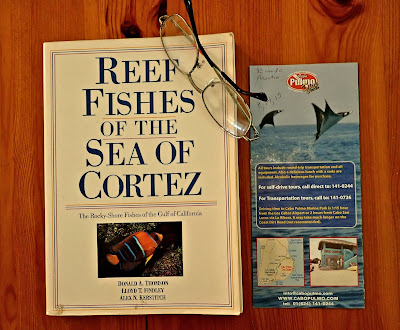It had been more than three weeks since we had visited the protected confines of Kawaihae Harbor and with the surf pounding in Kailua it seemed like it was time to venture north. We kept busy on the drive, receiving texts and calls from our friends and relatives in Oregon. If you haven't been in a cave for the last week, you know it was all about the fires. Sandra's daughter, has evacuated from Oregon City is still enjoying
 |
Kathy has the happiest goats!
|
the plush, if minuscule pleasures of Chateau Vancouver. Charles and Jeffrey were starting to emerge from the air conditioned safety of his house in Tualatin. Although that neighborhood is heavily forested, it had been spared. From a perspective that the evening news has not covered, there has been a capricious nature to the fires. Why Oregon City and not Tualatin?
Most touching was a long text we received from Kathy, who lives in the woods near Mollala. She and Vernon had made it back to the ranch (mind you, this is a real ranch) just that morning to find that the fire had not encroached upon their acres of woods. She praised a group of neighbors who had been going out daily to help battle the flames. With any luck, Kathy's pet goats will soon be back in their barn enjoying bucketfuls for goodies from their adoring mistress. Unless I am mistaken, this may represent the very and most endearing essence of capricious. Kathy loves the fish in Kona, but I'm pretty sure she loves her goats more.
With all of our friends and children (and grandchildren) safe, we arrived at Kawaihae in a peaceful state of mind. Soon we were across the giant car park and entering the water at the foot of the
 |
A Banded Coral Shrimp Ventures Out. Kawaihea September 2020
|
LST landing ramp. Heading out to the first platform I spotted a handsome cushion starfish on the bottom. Dressed in crimson and gold, it merited a photo, but I knew that picture would not make it into the blog. This is Kawaihae, for crying out load...we were sure to see something better than a cushion starfish!
Schmoopie and I reached the first platform, about twenty yards out from the ramp, swam around to the back side and were greeted by a banded coral shrimp. If you know how to do it, which is diving down ten feet, hanging on and looking around a corner, these colorful crustaceans are a sure thing at the first platform. This fellow, on the other hand, was on the side of a pylon about a foot below the surface and not especially frightened of us. I called Sandra over and she got her first excellent look at this charming animal. I nabbed a number of pictures with and without the flash. Unfortunately, the camera did not focus all that well except for one picture. As you can see, these are fairly big shrimp, measuring about five inches from elbow to elbow.
After about a minute the shrimp scuttled around to the inner side of his pillar and we swam around to
 |
Oval Butterflyfish, juvenile Kawaihae September 2020
|
the other side of the platform. Currently back in Kona, the Reef Teachers at Kahalu'u are all agog about a single juvenile Hawaiian dascyllus, which they delight in naming the Domino Dascyllus. I love that fish as well, but almost every
Pocillopora coral on the pillars here at Kawaihae is home to a few of these endearing little fish. So that Lone Ranger at K Bay does not hold as much interest for me. I was setting up to take a few pictures of the dascyllus on a large cauliflower coral when what should I see, darting among the stony leaves, but a tiny juvenile butterfly. And not just any juvenile butterfly, but an oval! I don't know how you cont 'em, but I have a special list for distinct juvenile fish. As you can see, this tot is super distinctive, so there I was, basking in the glow of life fish city.
There are several distinctive features about this fish. The shape, certainly, which is dominated by the distinctive dorsal fin bearing a handful of erect spines. But look at that odd spot on the caudal peduncle. I mean, what is that bright yellow slash all about? Additionally, he has a curiously shaped caudal fin that is a dark chocolate on the outside and creamy white in the middle. Yummy! And the yellow leading spines mirror the bright yellow pectoral fins. Were it not for those burgundy longitudinal stripes, I wouldn't have been able to put a name on it.
 |
An orgy of painted nudibranchs, Count the five gill clusters.
|
If you are unaware, that ventral fin is nothing like the same fin on the adult, neither in shape or coloration.
The baby oval was quite active, as many baby butterflyfish are. In addition, he spent the vast majority of his time between the leaves of the cauliflower coral. He wasn't hiding in there, but actively foraging. I assume he was nipping at the polyps (did you know that many butterflyfish eat coral polyps?) He was only as big as a silver dollar and he would emerge only for an instant to reposition himself between a different set of leaves. I worked on taking his picture for five minutes or so while Sandra swam circles over by the breakwater.
 |
| A painted nudibranch plastered against the pillar |
Before we leave this tiny beauty, I would just like to point out that if you have a handy copy of John Hoover's Ultimate Guide handy, you will note that there is no picture of this fascinating juvenile. You can be assured that he has access to pictures taken by all sorts of expert marine photographers. To put it another way, this is some kinda rare sighting! And John, if you're still out there you have my permission to use this picture in your next book.
On the page facing the oval, John shows us the juvenile milletseed. I haven't seen that one yet. There are certainly plenty of milletseed adults in Kawaihae Harbor, which has proved itself to be quite the nursery, so we should keep ourselves alert for the milletseed keiki.
Soon we were out at the second platform. I swam into the middle and found a tiny painted nudibranch nestled among some orange and purple sponges. I was trying for a picture when Sandra called me away. What she had found was a veritable orgy of painted nudibranchs. I counted four, but as you can see from this less than delightful photograph there are five painted nudibranchs slithering around one another. A few feet away my beloved found a single painted nudibranch splayed out against the cement pillar. While some nudibranchs routinely appear in this flattened posture, this is unusual for this species and gives us an interesting look at his coloration.
 |
Adolescent Scribble Filefish Kawaihae September 2020
|
Around the third platform we enjoyed a variety of feather duster worms and one nice trembling nudibranch that was bout ten feet down. I was wearing my weights, so I was able to get am acceptable picture of this chubby little fellow. Note that one of his rhinophores is aiming off to the side. I don't spend a great deal of time watching the molluscs in my yard, so I don't know how much the snails and slugs manipulate their rhinophores (which in their case are also called tentacles) but I'll have to watch for that. There is no way that a land snail is going to rival a trembling nudibranch for sheer beauty, but they do have distinctive tentacles.
As we were making our way back in I was looking for nudis around the second platform. Suddenly from over by the breakwater Sandra yelled, "Come quick! Filefish!" What she had was a gorgeous adolescent Scribbled filefish. She got me onto it and I followed her for a couple minutes taking pictures. It was so still and the fish moved slowly around the reef. It was a magical experience.
Sometimes we forget how transparent the tail is on some of our fish. In this instance the large broom-shaped tail is banded with dark brown and lighter areas. If you look closely, halfway down the dorsal side of the tail you will note a bright coral that is visible even behind the tail.
 |
A second look a the oval keiki in the coral.
|
On the way in, I stopped for another five minutes to get the picture of the juvenile oval butterflyfish that you saw earlier. And then we were ashore. While I was showering, our friend Hai came along, apparently at the end of a run. We talked about the juvenile oval, and he remarked that it was difficult to photograph...this from the master of the reef. After we got dried off, we wandered over to say hello to Lottie and baby Naia, who is now seven months. Naia was checking out the tail of a kite in the tree above her head. As I mentioned earlier, Kawaihae is a remarkable nursery, as much for Naia as for the fishes.
jeff
 |
| The adult oval butterfly, Kailua Pier 3016Add caption |
|
|
|
 |
The Trembling nudibranch says, "He went thata way."
|























